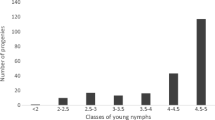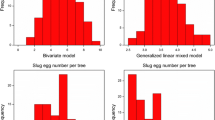Abstract
Cacopsylla pyri (pear psylla) is one of the most serious pests of pear (Pyrus spp.) in Europe. It can cause high yield losses, and its control has become difficult since it has developed resistance to a wide range of pesticides. Pear breeders are developing new cultivars resistant to pear psyllids, and Asian species, such as Pyrus ussuriensis and Pyrus × bretschneideri, are good sources of resistance. Antixenosis and antibiosis resistance to psylla were both identified in pear; they may differ in the biological mechanism and probably have different genetic backgrounds. We crossed interspecific P. × bretschneideri × Pyrus communis hybrid PEAR3, resistant to pear psylla, with the susceptible European pear cultivar ‘Moonglow’ to obtain an F1 population for the genetic mapping of the resistance. Quantitative trait locus (QTL) analysis was carried out for antibiosis by measuring the number of surviving nymphs and the nymphal development, using a novel phenotyping protocol and a saturated genetic map made of single-nucleotide polymorphism (SNP) and microsatellite (simple sequence repeats (SSR)) markers. A stable QTL was detected on linkage group (LG) 8 of PEAR3 (R 2 = 17.2–39.1 %). In addition, QTLs were detected on LG5 (R 2 = 10.8 %) of PEAR3 and on LG15 of ‘Moonglow’ (R 2 = 13.7 %).







Similar content being viewed by others
References
Atger P, Bigre JP (1982) Le psylle du poirier. Centre Technique Interprofessionnel des Fruits et Légumes, Paris
Bell RL (1984) Evaluation of Pyrus germplasm for resistance to the pear psylla. Acta Horticult 161:234–237
Bell RL (1992) Additional East European Pyrus germplasm with resistance to pear psylla nymphal feeding. HortSci 27:412–413
Bell RL (2013a) Host resistance to pear psylla of breeding program selections and cultivars. HortSci 48:143–145
Bell RL (2013b) Inheritance of resistance to pear psylla nymphal feeding in pear (Pyrus communis L.) of European origin. HortSci 48:425–427
Bell RL, Stuart LC (1990) Resistance in Eastern European Pyrus germplasm to pear psylla nymphal feeding. HortSci 25:789–791
Berrada S, Nguyen TX, Lemoine J et al (1995) Thirteen pear species and cultivars evaluated for resistance to Cacopsylla pyri (Homoptera: Psyllidae). Environ Entomol 24:1604–1607
Bouvier L, Bourcy M, Boulay M et al (2011) European pear cultivar resistance to bio-pests: scab (Venturia pirina) and psylla (Cacopsylla pyri). Acta Horticult 909:459–470
Buès R, Boudinhon L, Toubon JF (2003) Resistance of pear psylla (Cacopsylla pyri L.; Hom., Psyllidae) to deltamethrin and synergism with piperonyl butoxide. J Appl Entomol 127:305–312
Bus VGM, Chagné D, Bassett HCM et al (2008) Genome mapping of three major resistance genes to woolly apple aphid (Eriosoma lanigerum Hausm.). Tree Genet Genomes 4:223–236. doi:10.1007/s11295-007-0103-3
Bus VGM, Bassett HCM, Bowatte D et al (2010) Genome mapping of an apple scab, a powdery mildew and a woolly apple aphid resistance gene from open-pollinated Mildew Immune Selection. Tree Genet Genomes 6:477–487
Butt BA, Stuart LC, Bell RL (1988) Feeding behavior of pear psylla (Homoptra: Psyllidae) nymphs on susceptible and resistant Pyrus germplasm. J Econ Entomol 81:1394–1397
Calenge F, Drouet D, Denancé C et al (2005) Identification of a major QTL together with several minor additive or epistatic QTLs for resistance to fire blight in apple in two related progenies. Theor Appl Genet 111:128–35. doi:10.1007/s00122-005-2002-z
Cevik V, King G (2002) High-resolution genetic analysis of the Sd-1 aphid resistance locus in Malus spp. Theor Appl Genet 105:346–354
Chagné D, Crowhurst RN, Pindo M et al (2014) The draft genome sequence of European pear (Pyrus communis L. ‘Bartlett’). PLoS One. doi:10.1371/journal.pone.0092644
Churchill GA, Doerge RW (1994) Empirical threshold values for quantitative trait mapping. Genetics 138:963–71
Civolani S (2012) The past and present of pear protection against the pear psylla, Cacopsylla pyri L. Insecticides - Pest Engineering. INTECH Open Access Publisher, pp 385–408
Civolani S, Peretto R, Caroli L et al (2007) Preliminary resistance screening on abamectin in pear psylla (Hemiptera: Psyllidae ) in Northern Italy. J Econ Entomol 100:1637–1641
Civolani S, Grandi G, Chicca M et al (2013) Probing behaviour of Cacopsylla pyri on a resistant pear selection. J Appl Entomol 137:365–375. doi:10.1111/jen.12003
Collard BCY, Jahufer MZZ, Brouwer JB, Pang ECK (2005) An introduction to markers, quantitative trait loci (QTL) mapping and marker-assisted selection for crop improvement: the basic concepts. Euphytica 142:169–196. doi:10.1007/s10681-005-1681-5
Durel C-E, Denancé C, Brisset MN (2009) Two distinct major QTL for resistance to fire blight co-localize on linkage group 12 in apple genotypes ‘Evereste’ and Malus floribunda clone 821. Genome 52:139–147. doi:10.1139/G08-111
Evans KM, Govan CL, Fernández-Fernández F (2008) A new gene for resistance to Dysaphis pyri in pear and identification of flanking microsatellite markers. Genome 51:1026–31. doi:10.1139/G08-093
Feenstra B, Skovgaard IM, Broman KW (2006) Mapping quantitative trait loci by an extension of the Haley-Knott regression method using estimating equations. Genetics 173:2269–82. doi:10.1534/genetics.106.058537
Haley CS, Knott SA (1992) A simple regression method for mapping quantitative trait loci in line crosses using flanking markers. Heredity (Edinb) 69:315–24
Harries FH, Burts EC (1965) Insecticide resistance in the pear psylla. J Econ Entomol 58:172–173
Harris MK, Lamb RC (1973) Resistance to the pear psylla in pears with Pyrus ussuriensis lineage. J Am Soc Hortic Sci 98:378–381
Hesler LS, Tharp CI (2005) Antibiosis and antixenosis to Rhopalosiphum padi among triticale accessions. Euphytica 143:153–160. doi:10.1007/s10681-005-3060-7
Hodkinson ID (2009) Life cycle variation and adaptation in jumping plant lice (Insecta: Hemiptera: Psylloidea): a global synthesis. J Nat Hist 43:65–179. doi:10.1080/00222930802354167
Jansen RC (1993) Interval mapping of multiple quantitative trait loci. Genetics 135:205–211
Jansen RC, Stam P (1994) High resolution of quantitative traits into multiple loci via interval mapping. Genetics 136:1447–1455
Kapatos ET, Stratopoulou ET (1999) Duration times of the immature stages of Cacopsylla pyri L. (Hom., Psyllidae), estimated under field conditions, and their relationship to ambient temperature. J Appl Entomol 123:555–559. doi:10.1046/j.1439-0418.1999.00417.x
Lander ES, Botstein D (1989) Mapping mendelian factors underlying quantitative traits using RFLP linkage maps. Genetics 121:185–99
Lespinasse Y, Chevalier M, Durel C-E et al (2008) Pear breeding for scab and psylla resistance. Acta Horticult 800:475–482
Montanari S, Saeed M, Knäbel M et al (2013) Identification of Pyrus single nucleotide polymorphisms (SNPs) and evaluation for genetic mapping in European pear and interspecific Pyrus hybrids. PLoS One. doi:10.1371/journal.pone.0077022
Pasqualini E, Civolani S, Musacchi S et al (2006) Cacopsylla pyri behaviour on new pear selections for host resistance programs. Bull Insectology 59:27–37
Puterka GJ (1997) Intraspecific variation in pear psylla (Psyllidae: Homoptera) nymphal survival and development on resistant and susceptible pear. Environ Entomol 26:552–557
Robert P, Raimbault T (2004) Resistance of some Pyrus communis cultivars and Pyrus hybrids to the pear psylla Cacopsylla pyri (Homoptera, Psyllidae). Acta Horticult 671:571–575
Robert P, Guérif P, Lemoine J, Le Lézec M (2004) Criblage de génotypes de Pyrus vis-à-vis de la résistance au psylle du poirier Cacopsylla pyri (L.). Chaiers Agric 13:349–354
Roche P, Alston FH, Maliepaard C et al (1997) RFLP and RAPD markers linked to the rosy leaf curling aphid resistance gene (Sd 1) in apple. Theor Appl Genet 94:528–533
Salvianti F, Bettini PP, Giordani E et al (2008) Identification by suppression subtractive hybridization of genes expressed in pear (Pyrus spp.) upon infestation with Cacopsylla pyri (Homoptera: Psyllidae). J Plant Physiol 165:1808–16. doi:10.1016/j.jplph.2007.12.010
Schaub L, Graf B, Butturini A (2005) Phenological model of pear psylla Cacopsylla pyri. Entomol Exp Appl 117:105–111. doi:10.1111/j.1570-7458.2005.00339.x
Shaltiel-Harpaz L, Soroker V, Kedoshim R et al (2014) Two pear accessions evaluated for susceptibility to pear psylla Cacopsylla bidens (Šulc) in Israel. Pest Manag Sci 70:234–9. doi:10.1002/ps.3543
Stanica F (2002) Behaviour of four over grafted Chinese pear varieties (Pyrus serotina) in Bucuresti area. Acta Horticult 596:405–409
Stoeckli S, Mody K, Dorn S (2008a) Aphis pomi (Hemiptera: Aphididae) population development, shoot characteristics, and antibiosis resistance in different apple genotypes. J Econ Entomol 101:1341–8
Stoeckli S, Mody K, Gessler C et al (2008b) QTL analysis for aphid resistance and growth traits in apple. Tree Genet Genomes 4:833–847
Stoeckli S, Mody K, Gessler C et al (2009) Quantitative trait locus mapping of resistance in apple to Cydia pomonella and Lyonetia clerkella and of two selected fruit traits. Ann Appl Biol 154:377–387
Thode HC (2002) Testing for normality. CRC Press, New York
Van Ooijen JW (2004) MapQTL 5, Software for the mapping of quantitative trait loci in experimental population. Kyazma BV, Wageningen
Wang Y (2002) Genetic resources of deciduous fruit and nut crops in China. China Agricultural Science and Technology Press, Beijing
Westigard PH, Westwood MN, Lombard PB (1970) Host preference and resistance of Pyrus species to the pear psylla, Psylla pyricola Foerster. J Am Soc Hortic Sci 95:34–6
Wu J, Wang Z, Shi Z et al (2013) The genome of the pear (Pyrus bretschneideri Rehd.). Genome Res 23:396–408. doi:10.1101/gr.144311.112
Acknowledgments
SM was funded by the Fondazione Edmund Mach (FEM) PhD School. We greatly thank Déborah Renault, Jasmine McCarthy, Ferreol Braud, Sophie Aligon, Medhi Al-Rifai, Clement Joffrion, Sylvain Hanteville, Valérie Le Mignon, Arnaud Guyader, and Christine Boursier (UMR1345 IRHS, Angers, France) for their precious help in the scoring on C. pyri eggs and nymphs. We also thank Lester Brewer at PFR for generating the PEAR3 × ‘Moonglow’ cross and the INEM team of IRHS, especially Michel Boucourt, and the INRA Experimental Unit (UE Horti, Angers, France), especially Christian Cattanéo, for taking care of the seedling population.
Data archiving statement
QTL data are reported in Table 4 and will be made publicly available through the Genome Database for Rosaceae (www.rosaceae.org).
Author information
Authors and Affiliations
Corresponding author
Additional information
Communicated by E. Dirlewanger
Electronic supplementary material
Below is the link to the electronic supplementary material.
ESM_1
Psylla resistance phenotypic data distributions in a segregating interspecific pear population in 2013 and 2014. (PDF 189 kb)
ESM_2
Distribution of the phenotypic means of psylla resistance adjusted for environmental factors in a pear segregating population in 2013 and 2014. (PDF 321 kb)
Rights and permissions
About this article
Cite this article
Montanari, S., Guérif, P., Ravon, E. et al. Genetic mapping of Cacopsylla pyri resistance in an interspecific pear (Pyrus spp.) population. Tree Genetics & Genomes 11, 74 (2015). https://doi.org/10.1007/s11295-015-0901-y
Received:
Revised:
Accepted:
Published:
DOI: https://doi.org/10.1007/s11295-015-0901-y




